Abstract
Purpose
To evaluate short-term clinical outcomes following hyperopic laser-assisted subepithelial keratomileusis (LASEK) in Korean patients.
Methods
This retrospective study included 18 eyes of 10 patients who underwent hyperopic LASEK between May 2005 and March 2013 in Seoul National University Hospital. Visual acuity and spherical equivalent were evaluated preoperatively and at 1 and 3 months postoperatively. High order aberrations and contrast sensitivity were measured before and 3 months after the operation. Alternative prism cover test (APCT) was performed both preoperatively with correction and postoperatively without correction.
Results
The mean age of patients was 32 ± 11 years and the mean spherical equivalent refractive error was -2.95 ± 1.24 diop-ters (D). Uncorrected visual acuities were log MAR +0.17 ± 0.15 and log MAR +0.14 ± 0.15 at postoperative 1 month and 3 months, respectively and showed no significant difference in best corrected visual acuity (+0.25 ± 0.30). Spherical equivalent was -0.22 ± 1.22 D at 1 month and 0.38 ± 0.91 D at 3 months postoperatively. In 6 patients who had esotropia before the oper-ation, APCT was 7.83 ± 3.60 prism diopters (PD) esotropia at distance with correction preoperatively and 4.67 ± 5.65 PD at dis-tance without correction postoperatively. Three patients (16.7%) showed delayed wound healing with 1 (5.56 %) having persis-tent corneal opacity without significant visual loss.
Go to : 
References
1. McDonnell PJ, Moreira H, Clapham TN. . Photorefractive ker-atectomy for astigmatism. Initial clinical results. Arch Ophthalmol. 1991; 109:1370–3.
2. Saragoussi JJ, Abenhaim A, Hanna K. Keratomileusis in myopia. Bull Soc Belge Ophtalmol. 1989; 233:67–94.
3. El-Maghraby A, Salah T, Waring GO. 3rd. . Randomized bi-lateral comparison of excimer laser in situ keratomileusis and pho-torefractive keratectomy for 2.50 to 8.00 diopters of myopia. Ophthalmology. 1999; 106:447–57.

4. He L, Manche EE. Contralateral eye-to-eye comparison of wave-front-guided and wavefront-optimized photorefractive keratec-tomy: a randomized clinical trial. JAMA Ophthalmol. 2015; 133:51–9.
5. Shortt AJ, Allan BD, Evans JR. Laser-assisted in-situ keratomi-leusis (LASIK) versus photorefractive keratectomy (PRK) for myopia. Cochrane Database Syst Rev. 2013; 1:CD005135.

6. Hersh PS, Brint SF, Maloney RK. . Photorefractive keratectomy versus laser in situ keratomileusis for moderate to high myopia. A randomized prospective study. Ophthalmology. 1998; 105:1512–22. discussion 1522-3.

7. Han HS, Song JS, Kim HM. Long-term results of laser in situ kera-tomileusis for high myopia. Korean J Ophthalmol. 2000; 14:1–6.

8. Lui MM, Silas MA, Fugishima H. Complications of photo-refractive keratectomy and laser in situ keratomileusis. J Refract Surg. 2003; 19:(2 Suppl). S247–9.

9. Shortt AJ, Bunce C, Allan BD. Evidence for superior efficacy and safety of LASIK over photorefractive keratectomy for correction of myopia. Ophthalmology. 2006; 113:1897–908.

10. Zhao LQ, Zhu H, Li LM. Laser-assisted subepithelial keratectomy versus laser in situ keratomileusis in myopia: a systematic review and meta-analysis. ISRN Ophthalmol. 2014; 2014:672146.

11. Autrata R, Rehurek J. Laser-assisted subepithelial keratectomy for myopia: two-year follow-up. J Cataract Refract Surg. 2003; 29:661–8.

12. Teus MA, de Benito-Llopis L, García-González M. Comparison of visual results between laser-assisted subepithelial keratectomy and epipolis laser in situ keratomileusis to correct myopia and myopic astigmatism. Am J Ophthalmol. 2008; 146:357–62.

13. Autrata R, Rehurek J. Laser-assisted subepithelial keratectomy and photorefractive keratectomy for the correction of hyperopia. Results of a 2-year follow-up. J Cataract Refract Surg. 2003; 29:2105–14.

14. Settas G, Settas C, Minos E, Yeung IY. Photorefractive keratec-tomy (PRK) versus laser assisted in situ keratomileusis (LASIK) for hyperopia correction. Cochrane Database Syst Rev; 2012; 6:CD007112.

15. Alió JL, El Aswad A, Vega-Estrada A, Javaloy J. Laser in situ kera-tomileusis for high hyperopia (>5.0 diopters) using optimized as-pheric profiles: efficacy and safety. J Cataract Refract Surg 2013; 39. 519–27.
16. Shah S, Sheppard AL, Castle J. . Refractive outcomes of la-ser-assisted subepithelial keratectomy for myopia, hyperopia, and astigmatism using a 213 nm wavelength solid-state laser. J Cataract Refract Surg. 2012; 38:746–51.

17. McAlinden C, Skiadaresi E, Moore JE. Hyperopic LASEK treat-ments with mitomycin C using the SCHWIND AMARIS. J Refract Surg. 2011; 27:380–3.

18. Astle WF, Huang PT, Ereifej I, Paszuk A. Laser-assisted sub-epithelial keratectomy for bilateral hyperopia and hyperopic aniso-metropic amblyopia in children: one-year outcomes. J Cataract Refract Surg. 2010; 36:260–7.
19. Mohney BG, Lilley CC, Green-Simms AE, Diehl NN. The long- term follow-up of accommodative esotropia in a population-based cohort of children. Ophthalmology. 2011; 118:581–5.
20. Park KA, Kim SA, Oh SY. Long-term changes in refractive error in patients with accommodative esotropia. Ophthalmology. 2010; 117:2196–207.e1.

21. Yamada K, Ueta M, Sotozono C. . Upregulation of Toll-like re-ceptor 5 expression in the conjunctival epithelium of various hu-man ocular surface diseases. Br J Ophthalmol. 2014; 98:1116–9.

22. Magli A, Forte R, Gallo F, Carelli R. Refractive surgery for accom-modative esotropia: 5-year follow-up. J Refract Surg. 2014; 30:116–20.

23. Brugnoli de Pagano OM, Pagano GL. Laser in situ keratomileusis for the treatment of refractive accommodative esotropia. Ophthalmology. 2012; 119:159–63.

24. Stidham DB, Borissova O, Borissov V, Prager TC. Effect of hyper-opic laser in situ keratomileusis on ocular alignment and stereopsis in patients with accommodative esotropia. Ophthalmology. 2002; 109:1148–53.
25. Leccisotti A. Femtosecond laser-assisted hyperopic laser in situ keratomileusis with tissue-saving ablation: analysis of 800 eyes. J Cataract Refract Surg. 2014; 40:1122–30.

26. Tomita M, Watabe M, Yukawa S. . Safety, efficacy, and pre-dictability of laser in situ keratomileusis to correct myopia or my-opic astigmatism with a 750 Hz scanning-spot laser system. J Cataract Refract Surg. 2014; 40:251–8.

27. Lee JY, Kim MK, Kim SJ, Wee WR. Delayed corneal epithelial healing after hyperopic laser-assisted subepithelial keratectomy in patients with accommodative esotropia. JCRS Online Case Reports. 2013; 1:e44-8.

Go to : 
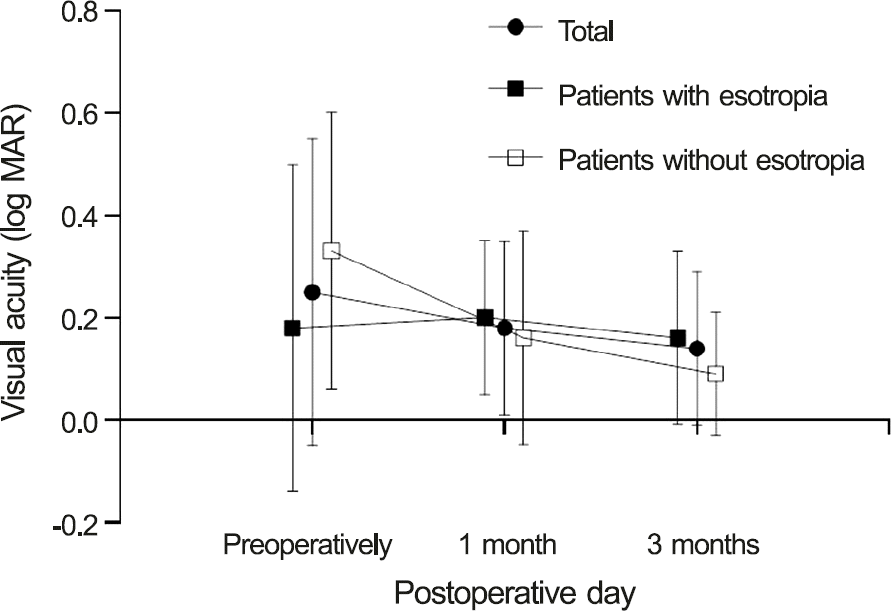 | Figure 1.Visual acuity change preoperatively, 1 month and 3 months postoperatively. The visual acuity was converted to decimal form after calculation of mean and standard deviation with log MAR visual acuity (no statistical difference between preoperative and postoperative 1 and 3 months). |
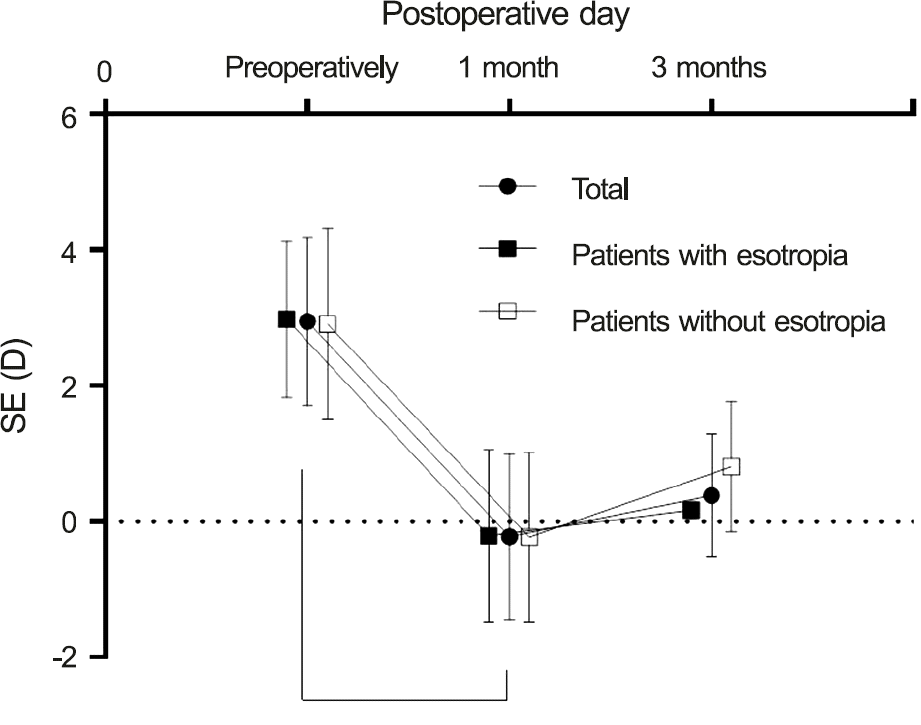 | Figure 2.SE change preoperatively, 1 month and 3 months postoperatively. SE = spherical equivalent. * p < 0.05, paired samples t-test. |
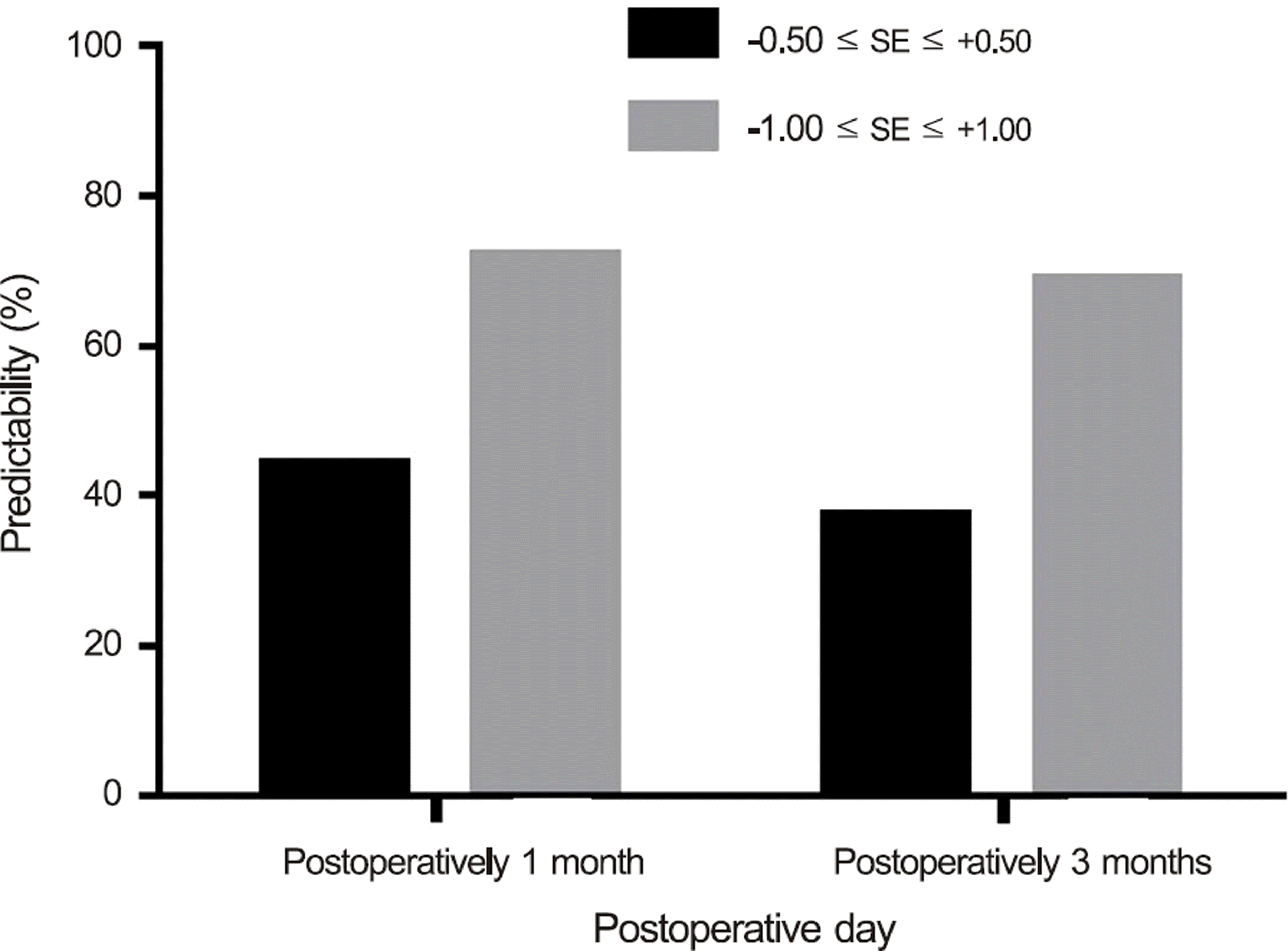 | Figure 3.Predictability. The percentage of eyes within ±0.5 D and ±1.0 D of intended correction. SE = spherical equivalent. |
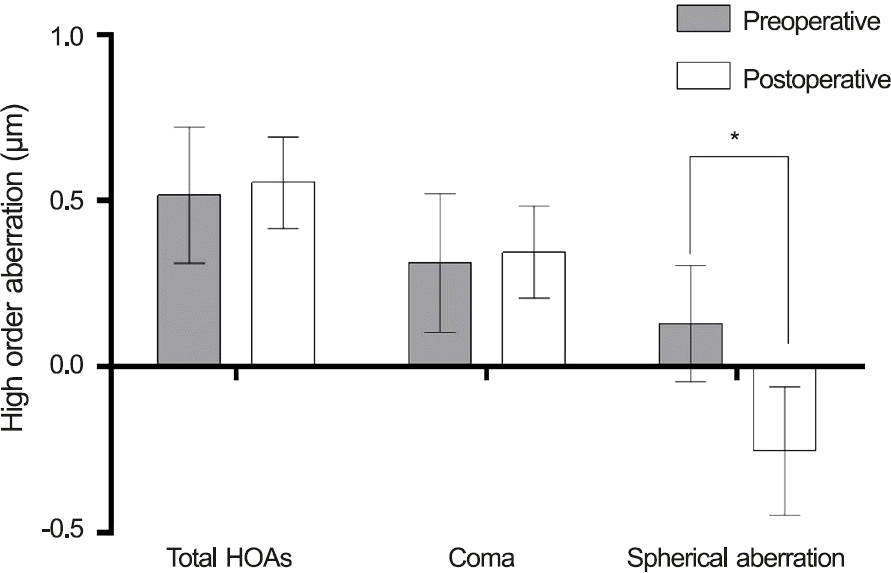 | Figure 4.Comparison of pre- and postoperative 3 months high order aberration values. HOA = high order aberration. * p < 0.05, paired samples t-test. |
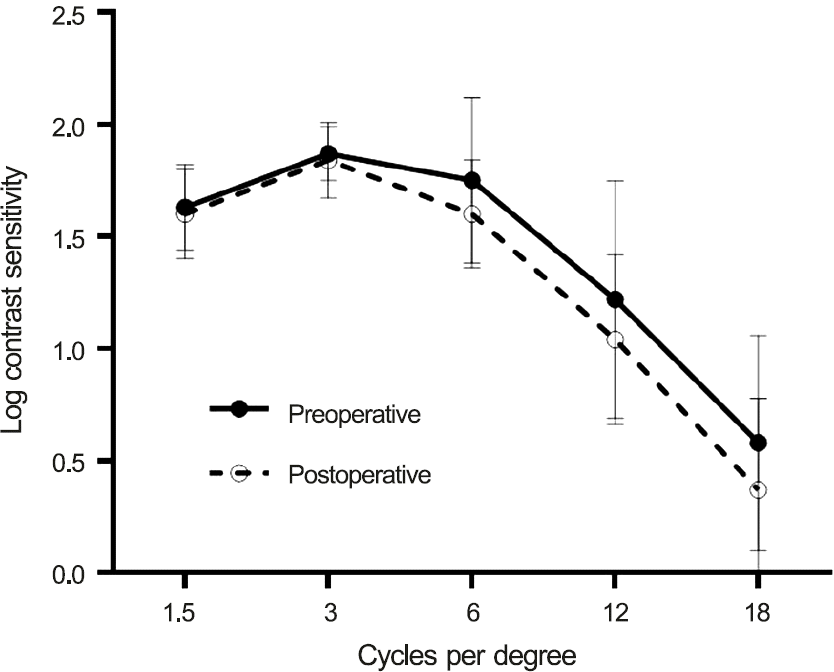 | Figure 5.Mean contrast sensitivity (in logarithmic scale) at pre- and postoperative 3 months. |
Table 1.
Patients preoperative and postoperative demographics
Preop = preoperative; BCVA = best corrected visual acuity; SE = spherical equivalent; deviation = angle of deviation; PD = prism diopter; Postop = postoperative; UCVA = uncorrected visual acuity; F = female; M = male; XT = exotropia; OU = oculus uterque (both eyes); LASEK = laser assisted subepithelial keratectomy; ET = esotropia; RH = right hypertropia; OD = oculus dexter (right eye); OS = oculus sinister (left eye); Ortho = orthotropia; LH = left hypertropia.




 PDF
PDF ePub
ePub Citation
Citation Print
Print


 XML Download
XML Download